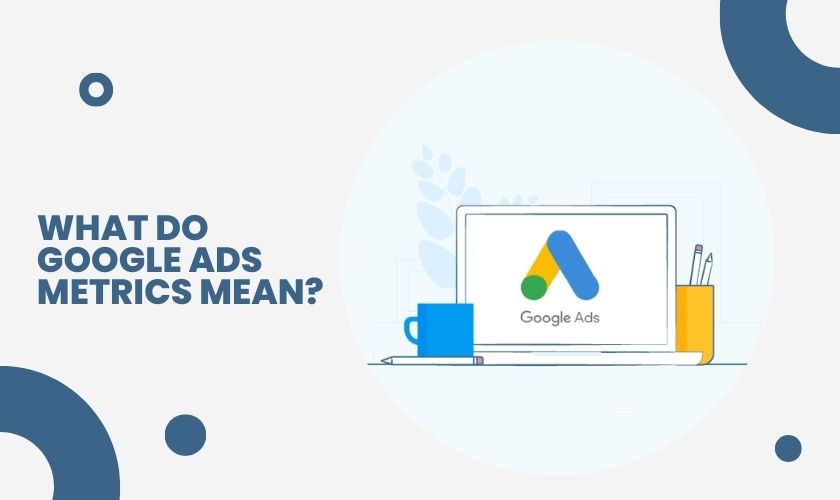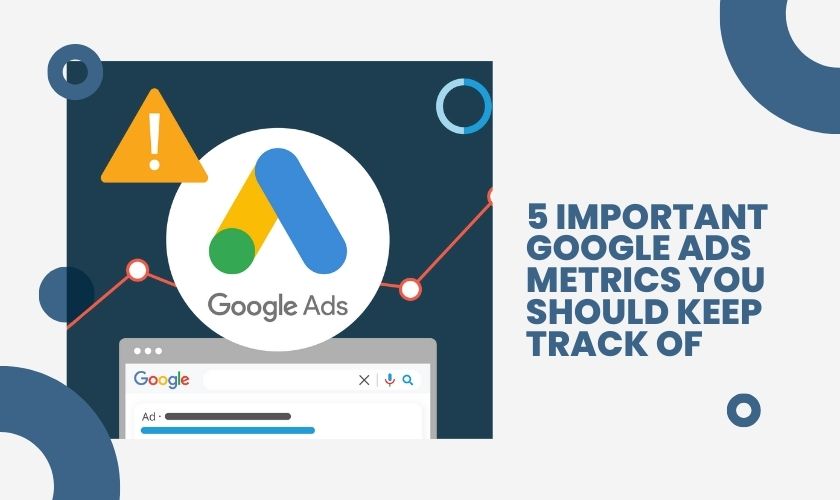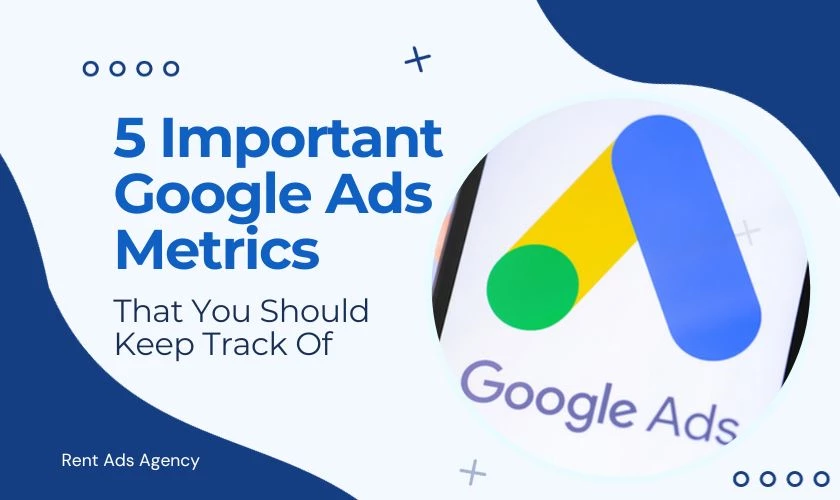Google Ads is like a powerful tool for businesses to reach their target audience and win in the fight for Internet advertising customers. However, staying on top of your reports may be tricky, and you might not be familiar with all Google Ads metrics. That’s where Rent Ads Agency comes in!
In this article, we’ll walk you through the top 5 most important metrics that every advertiser should track to get accurate insights of how your campaigns are doing to optimize your campaigns.
What do Google Ads metrics mean?
Google Ads metrics are the indicators that provide you with information about your ad performance and recommendations for what to do next. From that, you’ll be able to determine what’s working and what isn’t and make necessary adjustments.

There are numerous metrics in Google Ads, from impressions to conversions and everything in between. These indicators, such as CPCs, CPAs, and Quality Score, can enhance ROI and optimize Google Ads campaigns. Others, such as Budget Limits or Impression Share, on the other hand, exist purely to persuade your agency that your customer needs to spend more on Google Ads (even though occasionally, you don’t).
Some Google Ads metrics, including CPCs (cost-per-click), CPAs (cost-per-acquisition), and Quality Score, can enhance ROI (return on investment) and optimize Google Ads campaigns. On the contrary, other metrics such as Budget Limits or Impression Share, can let you know that your campaigns may be constrained by limitations or missing opportunities.
In the next section, we’ll discuss each metric in detail, from what they are, how to determine them, and how you can optimize these metrics.
5 important Google Ads metrics you should keep track of
1. Click-Through Rate (CTR)
Click-Through Rate (CTR) is the percentage of users who click on your ad after seeing it. It suggests that your ad is relevant and engaging, prompting viewers to click and learn more.
A high CTR is what you’re aiming for, as it signifies that your ad's message, design, and placement are effectively capturing the attention of your target audience. On the other hand, a low CTR may indicate potential issues with keyword targeting, ad messaging, or even the ad's visual elements.
CTR is calculated by the formula:
CTR = (Clicks / Impressions) * 100
For example, if an ad receives 100 impressions and generates five clicks, the CTR would be 5%.
You can increase your Click-Through Rate by
- Writing brief, catchy, and relevant ad content to the target audience's interests.
- Making a proper landing page for your ad. A seamless transition from ad to landing page is essential. Make sure that your landing page reflects the ad's message and offers a friendly user experience.
- Testing different ad formats, including text, display, and video ads to determine which is most engaged.
- Running A/B tests to analyze different ad variations to find out which elements resonate best with the target audience.
2. Conversion Rate (CR)
Conversion Rate represents the ratio of clicks to conversions, such as a purchase or sign-up. It is one of the most important Google Ads metrics that you should track constantly.
This metric is determined by the formula:
Conversion Rate = (Conversions / Clicks) * 100
For example, if an ad generates 100 clicks and results in 20 conversions, the Conversion Rate would be 20%.
As you pay per click, a low conversion rate can be a big challenge. For example, if your conversion rate falls between 0.1 - 5%, it means that you are paying too much for each transaction.
If the conversion rate of your campaign needs improvement, here’s how you can improve it:
- Target specific keywords instead of general ones. This will help you reach a more relevant and engaged audience, which will then potentially boost conversion rates.
- Employ negative keywords to prevent your ad from appearing for irrelevant searches. It will also help refine your ad targeting and ensure your ad reaches those most likely to convert.
- Search keyword reports: These reports help you identify the exact words users search for. Based on this data, you can strategically exclude or include specific keywords to enhance conversion rates.

3. Cost Per Click (CPC):
The cost per click (CPC) is the amount you pay each time a user clicks on your ad. CPC is calculated by the following formula:
CPC = Total Cost / Clicks
Though it is a priority to lower the CPC, maintaining the quality of clicks and subsequent conversions is also an important task. A low CPC is a good sign, but if these clicks aren't converting to transactions, you may need to reevaluate this financial metric in light of the overall campaign goals.
An increasing CPC might suggest heightened competition for your designated keywords or a potential decrease in the relevance of your ads. Conversely, a decreasing CPC, coupled with the maintenance or improvement of other performance metrics such as conversion rate, could indicate improved campaign efficiency.
The following suggestions can help you lower cost per clicks:
- Choosing relevant and high-performing keywords corresponding to the target audience's search queries attracts more qualified clicks, which will then lower CPCs
- Creating engaging ad copy that engages with the target demographic and correlates with the chosen keywords to increase ad relevance
- Testing various bidding tactics, such as manual and automatic bidding to determine the most cost-effective campaign strategy.
4. Return on Ad Spend (ROAS)
Return on Ad Spend (ROAS) is the amount of money earned for every dollar used for Google Ads. It provides insight into the efficiency and effectiveness of advertising campaigns. A favorable ROAS suggests that the advertising endeavors generate more revenue than the expenditure, signifying a successful campaign. On the contrary, a negative or low ROAS may suggest areas that require strategic adjustments.
ROAS is calculated by dividing the revenue from ads by the cost of those ads.
ROAS = Revenue / Total cost
For example, if your ad campaign generates $1000 in revenue and costs $200, the ROAS would be 5:1, indicating that for every dollar spent on advertising, $5 in revenue was generated.
You can improve ROAS with the following suggestions:
Bidding bids determined by keyword relevance, location, and device may affect ad position and enhance ROAS.
Improving targeting criteria to guarantee that ads contact the most relevant audience.
Focusing on high-performing keywords that consistently create conversions
5. Quality Score
The quality score is a Google Ads metric assessing the quality and relevance of your keywords and PPC ads, graded on a scale from 1 to 10, where 10 is the highest. This score consolidates various elements, including your keyword's click-through rate (CTR), the appropriateness of your ad text, the effectiveness of your landing page, and the historical performance of your Google Ads account.
While Google does not provide the exact method used to calculate Quality Score, it is determined by three critical factors:
- Ad Relevance: How well the ad's content and messaging match the user's search query and purpose.
- They expected Click-Through Rate (CTR): The probability that a user would click on an advertisement based on its relevance and attraction.
- The standard and suitability of the landing page that users arrive at after clicking on the ad.
If you’re seeking to enhance your Google Ads’ quality score, these tips can be helpful:
- Create straightforward, easy to understand ad content that is relevant to the interests and searches of the target audience.
- Choose appropriate and effective keywords that match the ad's message and the user's intent.
- Provide effective landing page experience that reflects the advertisement's message, allow seamless user navigation, and convey the requested user action.
- Review and update campaigns regularly to keep up with high-quality standards and respond to changing user behavior and market trends.
The bottom line
As the success of your campaigns hinges on the strategic management of these Google Ads metrics, using a well-managed Google Ads account ensures that your advertising budget is optimized, and you are moving closer to your marketing goals.
For businesses seeking expert assistance in navigating the complexities of Google Ads, Rent Ads Agency is your one-stop solution. Our complete service includes providing Google agency accounts tailored to the unique needs of businesses, offering in-depth tutorials and strategic insights to maximize the impact of your advertising efforts. By partnering with Rent Ads Agency, businesses can leverage their proficiency to achieve precision and confidence in their Google Ads campaigns, ultimately driving success in the competitive landscape of online advertising.
Contact Rent Ads Agency today to discover the untapped potential that lies within your reach!

Mohamed Fouad is a full-stack web developer and an entrepreneur who's really into advertising. He is the CEO of Rent Ads Agency, a company that helps businesses reach more customers through advertising. He graduated from Stanford University in 2018 and has over 4 years of experience in the tech industry.




